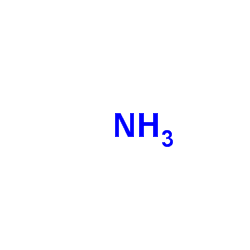24646-85-3
| Name | azanylidynevanadium |
|---|---|
| Synonyms |
vanadium nitride
vanadium mononitride nitridovanadium |
| Density | 6.13 g/mL at 25 °C(lit.) |
|---|---|
| Melting Point | 2320ºC |
| Molecular Formula | NV |
| Molecular Weight | 64.94820 |
| Exact Mass | 64.94700 |
| PSA | 23.79000 |
| LogP | 0.01508 |
| Appearance | Powder | black |
| Water Solubility | insoluble H2O; soluble aqua regia [HAW93] |
|
Section 1: Product Identification Chemical Name:Vanadium nitride (99.5%-V) CAS Registry Number:24646-85-3 Formula:VN EINECS Number:246-382-4 Chemical Family:metal nitride Synonym:none
Section 2: Composition and Information on Ingredients IngredientCAS NumberPercentACGIH (TWA)OSHA (PEL) Title compound24646-85-3100%no datano data Section 3: Hazards Identification Emergency Overview:May be irritating to skin and eyes and respiratory tract. Primary Routes of Exposure:Ingestion, inhalation Eye Contact:May be a mild to severe irritant to the eyes. Skin Contact:May cause slight to mild irritation of the skin. Inhalation:Do not breath dust. Inhalation of powder may lead to irritation of the respiratory tract. Ingestion:No information on the physiological effects of ingestion. Acute Health Affects:May be irritating to skin, eyes, mucous membranes and respiratory tract. Do not breath dust. Chronic Health Affects:No information available on long-term chronic effects. NTP:No IARC:No OSHA:No SECTION 4: First Aid Measures Immediately flush the eyes with copious amounts of water for at least 10-15 minutes. A victim may need Eye Exposure: assistance in keeping their eye lids open. Get immediate medical attention. Wash the affected area with water. Remove contaminated clothes if necessary. Seek medical assistance if Skin Exposure: irritation persists. Remove the victim to fresh air. Closely monitor the victim for signs of respiratory problems, such as difficulty in Inhalation: breathing, coughing, wheezing or pain. In such cases seek immediate medical assistance. Seek medical attention immediately. Keep the victim calm. Give the victim water (only if conscious). Induce Ingestion: vomiting only if directed by medical personnel. SECTION 5: Fire Fighting Measures Flash Point:no data Autoignition Temperature:no data Explosion Limits:no data Extinguishing Medium:carbon dioxide, dry powder or foam. If involved in a fire, fire fighters should be equipped with NIOSH approved positive pressure self-contained Special Fire Fighting Procedures: breathing apparatus and full protective clothing. Hazardous Combustion andNo hazardous combustion or decomposition products. Decomposion Products: Unusual Fire or Explosion Hazards: No unusual fire or explosion hazards. SECTION 6: Accidental Release Measures Small spills can be mixed with vermiculite, sodium carbonate or other suitable non combustible adsorbent and Spill and Leak Procedures: swept up. SECTION 7: Handling and Storage Handling and Storage:Store the material in a tightly sealed container. Keep away from heat. SECTION 8: Exposure Controls and Personal Protection Eye Protection:Always wear approved safety glasses when handling a chemical substance in the laboratory. Skin Protection:Wear protective clothing and gloves. Ventilation:Material may form a fine dust. If possible, handle the material in an efficient fume hood. If ventilation is not available a respirator should be worn. The use of respirators requires a Respiratory Respirator: Protection Program to be in compliance with 29 CFR 1910.134. Ventilation:Material may form a fine dust. If possible, handle the material in an efficient fume hood. Additional Protection:No additional protection required. SECTION 9: Physical and Chemical Properties Color and Form:black powder Molecular Weight:64.95 Melting Point:2320° Boiling Point:no data Vapor Pressure:no data Specific Gravity:6.13 Odor:not determined Solubility in Water:insoluble SECTION 10: Stability and Reactivity Stability:air and moisture stable Hazardous Polymerization:No hazardous polymerization. Conditions to Avoid:none Incompatibility:oxidizing agents Decomposition Products:none SECTION 11: Toxicological Information RTECS Data:No information available in the RTECS files. Carcinogenic Effects:no data Mutagenic Effects:no data Tetratogenic Effects:no data SECTION 12: Ecological Information Ecological Information:No information available SECTION 13: Disposal Considerations Disposal:Dispose of according to local, state and federal regulations. SECTION 14: Transportation Shipping Name (CFR):Non-hazardous Hazard Class (CFR):NA Additional Hazard Class (CFR):NA Packaging Group (CFR):NA UN ID Number (CFR):NA Shipping Name (IATA):Non-hazardous Hazard Class (IATA):NA Additional Hazard Class (IATA):NA Packaging Group (IATA):NA UN ID Number (IATA):NA SECTION 15: Regulatory Information TSCA:Listed in the TSCA inventory. SARA (Title 313):See Category Code N770 for reporting. Second Ingredient:none SECTION 16 - ADDITIONAL INFORMATION N/A |
| Precursor 5 | |
|---|---|
| DownStream 0 | |








